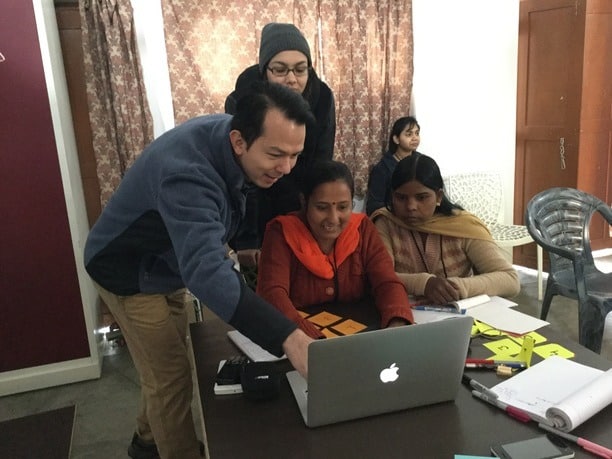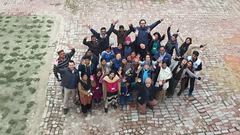Project: We just wrapped up our project with VMware and CARE India in Hardoi, India from January 10 – 23, 2016. VMware’s 11 volunteers came from six countries: Bulgaria, Canada, Costa Rica, India, Singapore, and the United States. Prior to arriving in Hardoi, they spent six weeks preparing equipment installation and lesson plans. They then spent two weeks in a rural town called Hardoi in Uttar Pradesh, delivering an intensive IT teacher training course.
This will be a three-part blog post to share with you the background, stories, and impact of our project.
Part 1- VMware volunteers and Udaan teachers at Udaan School
Udaan: Leading Model School in India
The school, Udaan Hardoi, is a joint program between the non-governmental organizations CARE India and Sarvodaya Ashram. Udaan is considered a model residential bridge-building school. Within a mere 11 months, girls who have dropped out of school or have never been to school complete grades 1 to 5, and 90 percent of the girls are mainstreamed into formal education. In addition, they gain a level of self-confidence that is rarely seen in adolescent girls.
When we first visited the school, we were surprised that there were no textbooks or tables in the classroom; instead students sat in a semi-circle on the floor. A teacher told us the reasoning behind this is the teacher is always an arm’s length away from any girl to offer help. Lessons are focused on learning concepts rather than memorizing facts. The teachers employ innovative methods to teach the girls, using sticks to demonstrate addition and subtraction, anda game of circling plural and singular words on the blackboard to teach vocabulary.
Udaan’s Math teacher, Seema Singh, using paper to teach digits
With only six teachers and 100 girls, the daily operations of the residential school are handled by committees set up by the girls: the students, not the teachers, set the rules. Another unique component of Udaan’s curriculum is the daily social learning period when the girls and teachers discuss important topics such as child marriage and family planning.
Visiting Swati’s home
During our second day of the project, we visited several girls who have graduated from Udaan Hardoi at their village. Swati[1], the girl whom I visited, was the first in her family to pursue post-primary education. Unfortunately, her two older sisters never had the opportunity to attend school. However, because of Swati’s academic success, her parents are now committed to putting her and her younger siblings through college. The alumni girls were confident and ambitious, unapologetically enthusiastic when describing their future goals to be teachers and doctors. When we heard the villagers voice their complaints that the local government has not established a primary school nearby or offered transportation to the nearby college, CARE India suggested that the alumni girls could act as spokespeople for their village.
We were amazed at Udaan’s innovative teaching methods and the teachers’ love and concern for their students. We could hardly wait to work with the teachers the following week.
The school, Udaan Hardoi, is a joint program between the non-governmental organizations CARE India and Sarvodaya Ashram. Udaan is considered a model residential bridge-building school. Within a mere 11 months, girls who have dropped out of school or have never been to school complete grades 1 to 5, and 90 percent of the girls are mainstreamed into formal education. In addition, they gain a level of self-confidence that is rarely seen in adolescent girls.
When we first visited the school, we were surprised that there were no textbooks or tables in the classroom; instead students sat in a semi-circle on the floor. A teacher told us the reasoning behind this is the teacher is always an arm’s length away from any girl to offer help. Lessons are focused on learning concepts rather than memorizing facts. The teachers employ innovative methods to teach the girls, using sticks to demonstrate addition and subtraction, anda game of circling plural and singular words on the blackboard to teach vocabulary.
With only six teachers and 100 girls, the daily operations of the residential school are handled by committees set up by the girls: the students, not the teachers, set the rules. Another unique component of Udaan’s curriculum is the daily social learning period when the girls and teachers discuss important topics such as child marriage and family planning.
Part 2 – What was our project about?
In partnership with CARE India, our project strived to:
- Enhance the girls’ abilities to understand concepts and increase their engagement with the use of technology;
- Build teachers’ digital literacy and introduce educational software to enhance their teaching;
- Build connections and be inspired.
We did this through a three part program. First, we took time to understand the needs of the teachers and students with whom we were working. We visited their school and were fascinated by their innovative methods in teaching. Then we visited several of the girls who graduated from Udaan Hardoi in their village. In the evenings, the volunteers eagerly revised their lesson plans to match the teachers’ digital literacy levels.
For the first week, our intention was to focus on the fundamentals of IT so the teachers would feel comfortable integrating technology into their classes. We covered PowerPoint, Word, Excel, Google Translate, Earth, Search, Email, Youtube, and many other basic digital literacy areas. The teachers especially loved using Google Translate and tried asking one of the volunteers whether he had eaten in Chinese, because they were concerned that he had skipped lunch to modify his lessons. Another teacher applied pivot tables to his Excel worksheet and proudly presented it the next day. He told us that, because of what he learned, it now takes him only 20 minutes to finish his analysis with increased accuracy, as opposed to the two weeks it had previously required.
Udaan teachers did not take a break because they were eager to continue practicing
For the second week, our intention was to introduce various educational software programs so the teachers would have multiple software options for use in their classes. The offline version of Khan Academy, KA Lite, was very popular among the math teachers, while Pratham Books, an electronic books resource, was very popular among the language teachers. When we asked the teachers whether they wanted to take breaks, none of them left their table because they were eager to continue practicing. They didn’t even stop to take a sip of chai or a bite of the afternoon snack!
VMware volunteer, Colin Png, working with Udaan teacher, Vandana Srivastava
Part 3 – What was our project’s impact?
In total, we spent 54 workshop hours with 14 teachers and coordinators from CARE India and Udaan schools from three states. The immediate beneficiaries of the project will be the 100 girls Udaan Hardoi admits annually. However, the number of potential beneficiaries is over 16,000 learners, as the teachers and coordinators we trained from the other states plan to bring their learning back to their respective schools.
Project Outputs:
With a matching grant from Team4Tech and CARE India, CARE India purchased:
- Six laptops – one for every teacher at the Udaan Hardoi school,
- Two projectors for the classrooms,
- One solar panel – to charge the equipment,
- One scanner printer,
- One router and internet bandwidth augmentation – since their internet connectivity was very weak prior to this project,
- One Raspberry Pi and its accessories to store KA Lite (offline version of Khan Academy).
As a gift, VMware provided:
- One LCD 43 inch TV – which ended up being more useful than the projector because it uses less electricity and was more affordable,
- Two digital cameras – which the teachers immediately used to take photos to upload onto their PowerPoint presentations as their first exercise,
- One portable hard disk – to use as a storage backup,
- One Raspberry Pi – as backup,
- One presentation clicker.
For software installed, CARE India asked that we teach about software that is free (because of their limited budget), in Hindi (because the teachers were not as comfortable in English), and offline (given the unreliable Internet connection). Therefore we taught and installed KA Lite, Pratham Books, Kiwix, Digital Study Hall, Azim Premji Foundation Education CDs, Microsoft Office and Windows Media Maker as offline software. We also showed them how to use search, social media, Google Earth, YouTube, and Google Translate, for times when they do have Internet access.
Udaan teacher, Vandana Srivastava, using Pratham Books to teach Hindi
Teacher Feedback:
Feedback from all of the teachers who participated in the training was highly positive:
- The training was rated, on average, 4.7 out of 5 in usefulness (with 5 being the highest),
- The training was rated, on average, 5 out of 5 in enjoyment,
- Everyone experienced an increase in skill level and usefulness for all the software taught, with Khan Academy having the biggest improvements.
On the very last day, the teachers integrated the software into their teaching with the students. Seema Singh, the math teacher, taught fractions using a blended approach of KA Lite, the chalkboard, and the exercise book, while the Hindi teacher, Vandana Srivastava, used Pratham Books to ask the students to read aloud and then asked questions to help them with their reading comprehension. The students and teachers loved the interaction from the Khan Academy videos and the beautiful illustrations from Pratham Books. That evening during reflection, we asked the volunteers to share a defining moment of the project. Many said it was when they saw the teachers integrate the software we taught them with their creative methods of teaching because it felt that the whole project finally came together.
What’s Next?
After having come back to our daily lives, many of us are missing the morning tea (chai) we enjoyed every morning when we arrived at the school, the friendships we built with the teachers and translators, and our daily evening reflections which helped us celebrate each other’s strengths and consolidate our observations and learning.
This project is only the beginning. We hope to continue partnering with CARE India to replicate their innovative teaching methods combined with technology to inspire more students throughout India. Stay tuned for future developments!
VMware volunteers, Udaan teachers, Team4Tech program manager, and CARE India staff
[1] This is a fictional name







